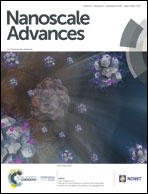Plasmonic coloration of silver nanodome arrays for a smartphone-based plasmonic biosensor†
Abstract
In this study, the utility of plasmonic coloration on silver nanodome arrays for sensitive and quantitative detection of biomolecules using a smartphone-based sensor is proposed. In particular, a quantitative analysis of DNA hybridization was achieved using the hue angle in the HSV color space obtained from a photograph of a sensing spot taken using a smartphone camera. Silver and gold nanodome arrays consisting of a polystyrene bead layer covered with a thin metal film can be created over a large area by a bottom–up fabrication process. The metal nanodome arrays exhibited unique colorations which can be tuned by the dome diameter ϕ, metal species, and refractive index of the surrounding medium. The measurement of the bulk refractive index sensitivity revealed that the Ag nanodome with ϕ = 500 nm can provide the highest sensitivity of up to 588 nm per refractive index unit. The detection of DNA hybridization was performed by using a bimetallic nanodome consisting of silver and thin gold overlayers and DNA modified gold nanoparticles (AuNPs) for enhancing the sensor signals. Upon the immobilization of AuNPs, the Ag nanodome (ϕ = 200 nm) exhibited a large shift in the resonance wavelength accompanied by a dramatic change in coloration. The analysis of detection sensitivity of DNA hybridization using a model system revealed that colorimetric detection based on hue can be used for the quantitative detection of biomolecules in the same manner as the spectroscopic method with a few pM level of detectable concentration.



 Please wait while we load your content...
Please wait while we load your content...